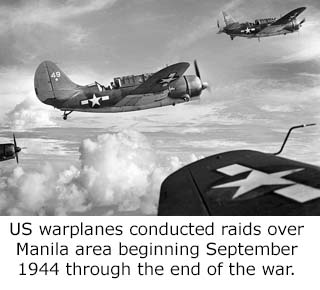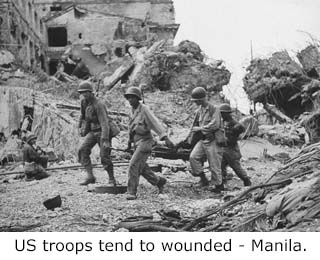The battle to liberate Manila lasted a month – between February 3 and March 3, 1945. The Japanese were the occupiers from whom the city and its surrounding areas were being liberated by American troops.
My dad was an American-in-hiding during the Japanese occupation of the Philippines. He had refused to submit himself to internment at the University of Santo Tomas campus where he was told by the US Embassy in Manila to proceed with his family at the onset of hostilities in 1941. I was seven years old at the time.

My dad went into hiding. He took me with him to seek refuge at the home of his oldest daughter (my sister Rosie) in Cubao, Quezon City, while my step-mother took my four brothers and sisters with her to lie low in Agoo, La Union in Northern Luzon. Hiding was quite difficult for my dad who was visibly Caucasian though my siblings and I easily passed for Filipinos.
My dad had a short-wave radio which he managed to keep undetected by the Japanese and from which he was able to get reliable information on the status of the war in both Europe and the Pacific. The Japanese military had earlier ordered everyone that owned radios to submit them to official censors so their “short wave” circuitry could be disabled.
 The Japanese military controlled information published by local broadcast and print media – propagating lies about the war situation. For example, during American air raids, I would count between 100 and 200 US Air Force planes in the sky and watch them from a hillside dive-bomb and strafe the nearby Camp Murphy which was occupied by the Japanese air force. Very, very rarely would I witness an American plane shot down during a raid. Each morning following an air raid, however, the Manila Tribune would run a headline that would read: “200 YANK PLANES SHOT DOWN OVER LUZON.”
The Japanese military controlled information published by local broadcast and print media – propagating lies about the war situation. For example, during American air raids, I would count between 100 and 200 US Air Force planes in the sky and watch them from a hillside dive-bomb and strafe the nearby Camp Murphy which was occupied by the Japanese air force. Very, very rarely would I witness an American plane shot down during a raid. Each morning following an air raid, however, the Manila Tribune would run a headline that would read: “200 YANK PLANES SHOT DOWN OVER LUZON.”
From short wave radio, we learned that American troops had made a landing in the north of Luzon – in Dagupan, Pangasinan. We also learned that General Douglas MacArthur made another landing on the southern island of Leyte, where he famously waded to shore.
 American forces started bombing vital Japanese bases and fortifications in the greater Manila area in September 1944. In the first week of February, 1945, rumors started spreading that American troops were coming into Quezon City from the north on their way to Manila at a time when I would be celebrating my twelfth birthday. A regiment of Japanese troops had fortified themselves at the Catholic nunnery and the water reservoir in Quezon City.
American forces started bombing vital Japanese bases and fortifications in the greater Manila area in September 1944. In the first week of February, 1945, rumors started spreading that American troops were coming into Quezon City from the north on their way to Manila at a time when I would be celebrating my twelfth birthday. A regiment of Japanese troops had fortified themselves at the Catholic nunnery and the water reservoir in Quezon City.
My dad and I followed the American forces from the time they arrived in Cubao, Quezon City, through the slow march to the city of Manila. My dad and I met the American troops and six American tanks that were heading to knock out the Japanese who were fortified at the Catholic nunnery and water reservoir in Cubao and then later to proceed to the city of Manila.
 The video accompanying this story shows 144 images of the death and destruction wrought by the liberation. Ninety-five percent of these images are credited to John Tewell who retired from the US Army and resided in Manila until his death. It was Mr. Tewell’s wish that these pictures be shared and propagated. Other pictures used in this video and story are official US Army photographs.
The video accompanying this story shows 144 images of the death and destruction wrought by the liberation. Ninety-five percent of these images are credited to John Tewell who retired from the US Army and resided in Manila until his death. It was Mr. Tewell’s wish that these pictures be shared and propagated. Other pictures used in this video and story are official US Army photographs.
The Manila landmarks that could be identified in the video include the Manila Hotel, the Army & Navy Club, the Elks Club, the U. S. High Commissioner’s Office building, the US Embassy, the Jai Alai building, the Bay View Hotel, the Luneta Hotel, the San Luis Terraces building, the Cathedral of St. Mary and St. John Episcopal, the Central Methodist Church, the Agriculture and Commerce buildings, the Legislative building, Manila’s City Hall building, the Manila Post Office building, the Metropolitan Theater, and the Adamson University buildings.

